
- school Campus Bookshelves
- menu_book Bookshelves
- perm_media Learning Objects
- login Login
- how_to_reg Request Instructor Account
- hub Instructor Commons
- Download Page (PDF)
- Download Full Book (PDF)
- Periodic Table
- Physics Constants
- Scientific Calculator
- Reference & Cite
- Tools expand_more
- Readability
selected template will load here
This action is not available.


1.1: Geometry Terms
- Last updated
- Save as PDF
- Page ID 2117
Define and use terms, including points, lines, planes, space, and postulates.
Geometric Definitions
A point is an exact location in space . It describes a location, but has no size. Examples are shown below:
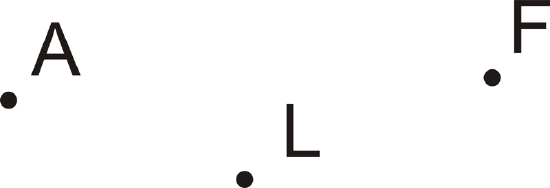
A line is infinitely many points that extend forever in both directions. Lines have direction and location and are always straight .

Figure \(\ PageIndex{2}\)
A plane is a flat surface that contains infinitely many intersecting lines that extend forever in all directions. Think of a plane as a huge sheet of paper with no thickness that goes on forever.
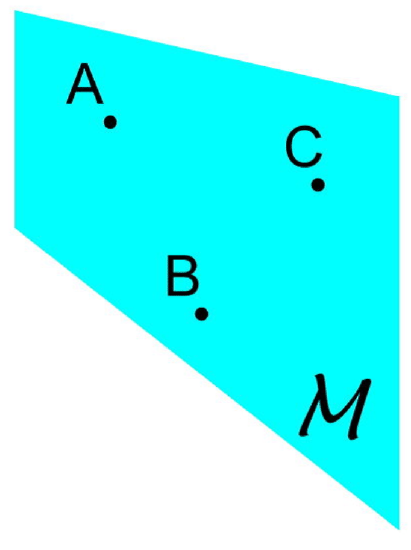
We can use point , line , and plane to define new terms.
Space is the set of all points extending in three dimensions . Think back to the plane. It extended in two dimensions, what we think of as up/down and left/right. If we add a third dimension, one that is perpendicular to the other two, we arrive at three-dimensional space.
Points that lie on the same line are collinear . \(P\),\(Q\),\(R\),\(S\), and \(T\) are collinear because they are all on line \(w\). If a point U were located above or below line w, it would be non-collinear .

Points and/or lines within the same plane are coplanar . Lines h and i, and points \(A\),\(B\),\(C\),\(D\),\(G\), and \(K\) are coplanar in Plane \(J\). Line \(\overleftrightarrow{KF}\) and point \(E\) are non-coplanar with Plane \(J\).
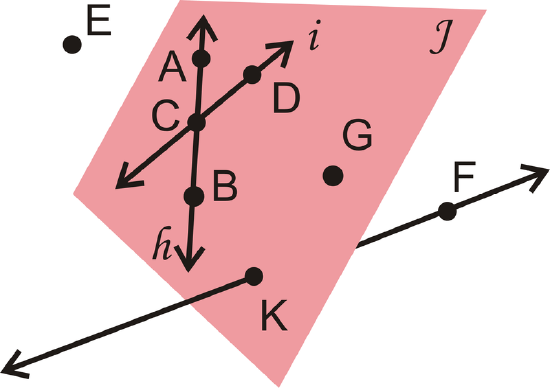
An endpoint is a point at the end of a line segment . A line segment is a portion of a line with two endpoints. Or, it is a finite part of a line that stops at both ends. Line segments are labeled by their endpoints. Order does not matter.

A ray is a part of a line. It begins with an endpoint and extends forever away from the endpoint in one direction, perfectly straight. A ray is labeled by its endpoint and one other point on the ray. For rays, order does matter. When labeling, put the endpoint under the side WITHOUT the arrow.

An intersection is a point or set of points where lines, planes, segments, or rays overlap.

A postulate is a basic rule of geometry. Postulates are assumed to be true (rather than proven), much like definitions. The following is a list of some basic postulates.
Postulate #1: Given any two distinct points, there is exactly one (straight) line containing those two points.
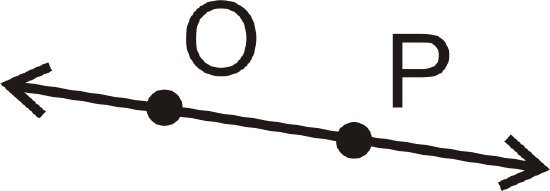
Postulate #2: Given any three non-collinear points, there is exactly one plane containing those three points.
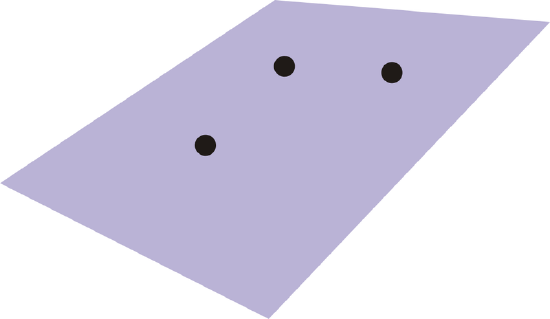
Postulate #3: If a line and a plane share two points, then the entire line lies within the plane.
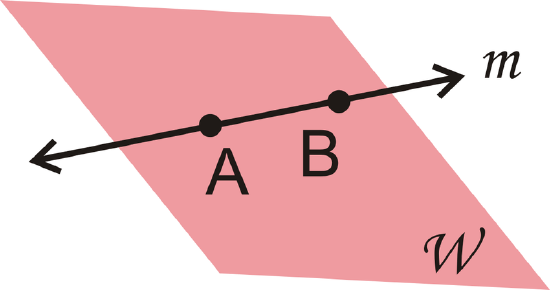
Postulate #4: If two distinct lines intersect, the intersection will be one point.
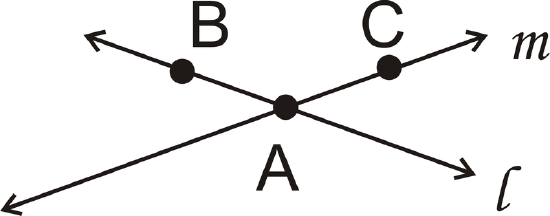
Lines \(I\) and \(m\) intersect at point \(A\).
Postulate #5: If two distinct planes intersect, the intersection will be a line.
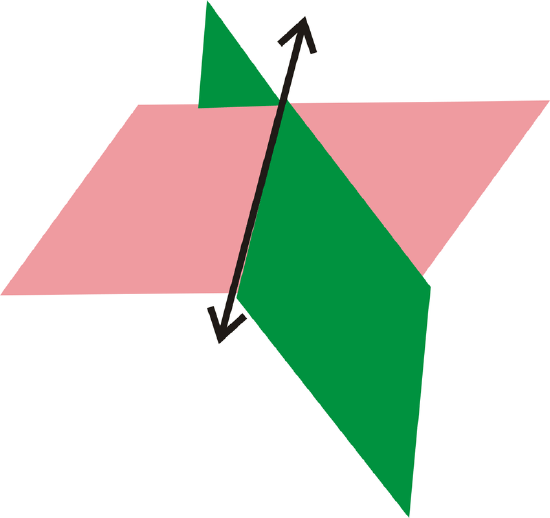
Figure \(\PageIndex{13}\)
When making geometric drawings, be sure to be clear and label all points and lines.
What if you were given a picture of a figure or object, like a map with cities and roads marked on it? How could you explain that picture geometrically?
Example \(\PageIndex{1}\)
What best describes San Diego, California on a globe: point, line, or plane?
A city is usually labeled with a dot, or point, on a globe.
Example \(\PageIndex{2}\)
Use the picture below to answer these questions.
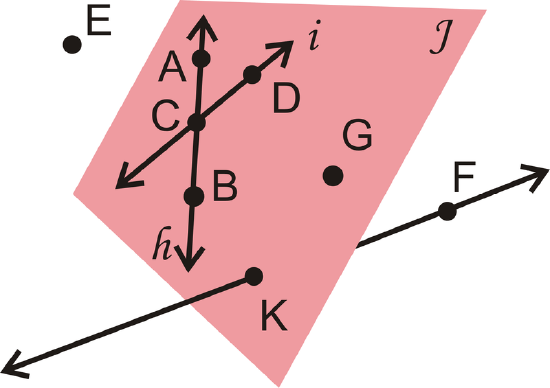
Figure \(\ PageIndex {14}\)
- List another way to label Plane \(J\).
- List another way to label line \(h\).
- Are \(K\) and \(F\) collinear?
- Are \(E\),\(B\) and \(F\) coplanar?
- Plane \(BDG\) is one possibility. Any combination of three coplanar points that are not collinear would be correct.
- \(\overleftrightarrow{AB}\). Any combination of two of the letters \(A\), \(B\), or \(C\) would also be correct.
- Yes, they both lie on \(\overleftrightarrow{KF}\).
- Yes, even though \(E\) is not in Plane \(J\), any three points make a distinct plane. Therefore, the three points create Plane \(EBF\).
Example \(\PageIndex{3}\)
What best describes a straight road that begins in one city and stops in a second city: ray, line, segment, or plane?
The straight road connects two cities, which are like endpoints. The best term is segment.
Example \(\PageIndex{4}\)
Answer the following questions about the picture.
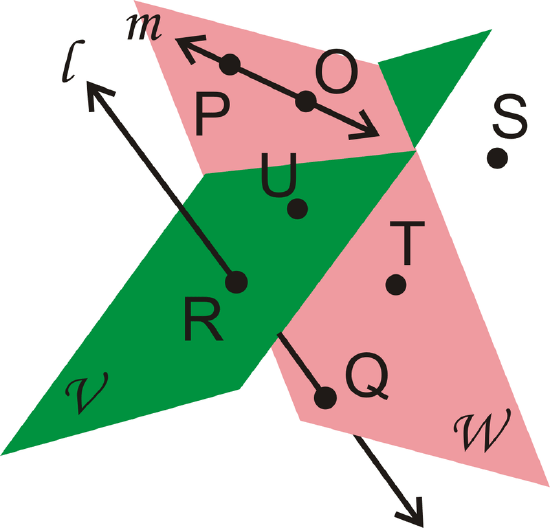
- Is line \(l\) coplanar with Plane \(V\), Plane \(W\), both, or neither?
- Are \(R\) and \(Q\) collinear?
- What point belongs to neither Plane V nor Plane \(W\)?
- List three points in Plane \(W\).
- Any combination of \(P\), \(O\), \(T\), and \(Q\) would work.
Example \(\PageIndex{5}\)
Draw and label a figure matching the following description: Line \(\overleftrightarrow{AB}\) and ray \(\overrightarrow{CD}\) intersect at point \(C)\. Then, redraw so that the figure looks different but is still true to the description.
Neither the position of A or B on the line, nor the direction that \(\overrightarrow{CD}\) points matter.
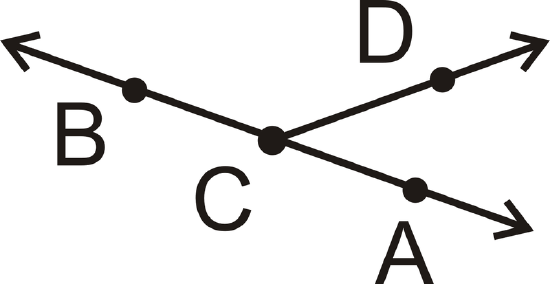
For the second part, this is one way to draw the diagram differently:
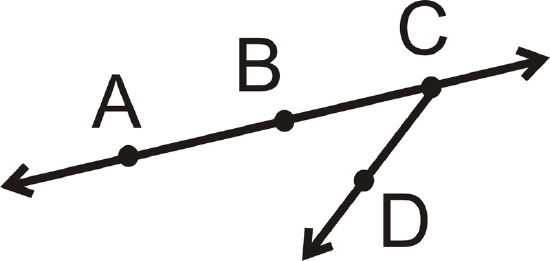
For questions 1-5, draw and label a figure to fit the descriptions.
- \(\overrightarrow{CD}\) intersecting \(\overline{AB}\) and Plane \(P\) containing \(\overline{AB}\) but not \(\overrightarrow{CD}\).
- Three collinear points \(A\), \(B\), and \(C\). \(B\) is also collinear with points \(D\) and \(E\).
- \(\overrightarrow{XY}\), \(\overrightarrow{XZ}\), and \(\overrightarrow{XW}\), such that \(\overrightarrow{XY}\) and \(\overrightarrow{XZ}\) are coplanar, but \(\overrightarrow{XW}\) is non-coplanar with both of the other rays.
- Two intersecting planes, \(P\) and \(Q\), with \(\overline{GH}\), where \(G\) is in plane \(P\) and \(H\) is in plane \(Q\).
- Four non-collinear points \(I\), \(J\), \(K\),and \(L\), with line segments connecting all points to each other.
- Name this line in five ways.

Figure \(\PageIndex{18}\)
- Name the geometric figure in three different ways.

Figure \(\PageIndex{19}\)
- Name the geometric figure in two different ways.
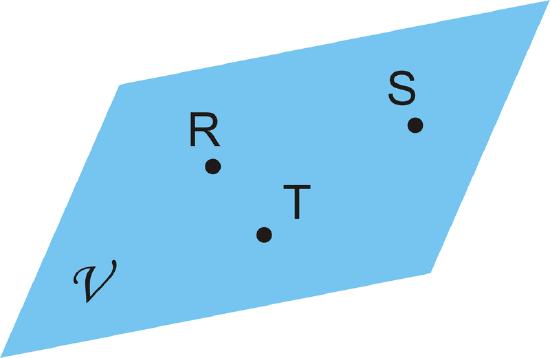
Figure \(\PageIndex{20}\)
- What is the best possible geometric model for a soccer field? Explain your answer.
- List two examples of where you see rays in real life.
- What type of geometric object is the intersection of a line and a plane? Draw your answer.
- What is the difference between a postulate and a theorem ?
For 13-16, use geometric notation to explain each picture in as much detail as possible.
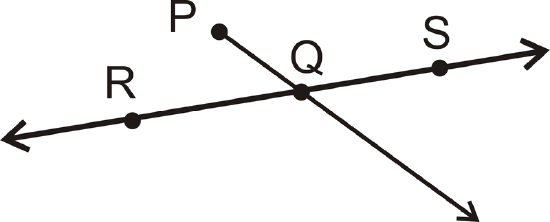
Figure \(\PageIndex{23}\)
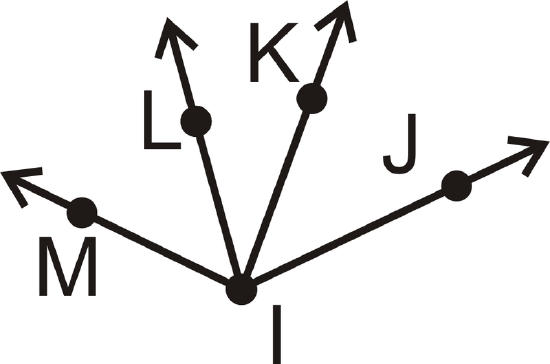
For 17-25, determine if the following statements are true or false.
- Any two points are collinear.
- Any three points determine a plane.
- A line is two rays with a common endpoint.
- A line segment is infinitely many points between two endpoints.
- A point takes up space.
- A line is one-dimensional.
- Any four points are coplanar.
- \(\overrightarrow{AB}\) could be read “ray \(AB\)” or “ray \(BA\).”
- \(\overleftrightarrow{AB}\) could be read “line \(AB\)” or “line \(BA\).”
Review (Answers)
To see the Review answers, open this PDF file and look for section 1.1.
Additional Resources
Interactive Element
Video: Basic Geometric Definitions Principles - Basic
Activities: Basic Geometric Definitions Discussion Questions
Study Aids: Basics of Geometry Study Guide
Practice: Geometry Terms
Real World: Basic Geometric Definitions

- school Campus Bookshelves
- menu_book Bookshelves
- perm_media Learning Objects
- login Login
- how_to_reg Request Instructor Account
- hub Instructor Commons
- Download Page (PDF)
- Download Full Book (PDF)
- Periodic Table
- Physics Constants
- Scientific Calculator
- Reference & Cite
- Tools expand_more
- Readability
selected template will load here
This action is not available.


1.1.4: Geometry
- Last updated
- Save as PDF
- Page ID 75883

- David Lippman
- Pierce College via The OpenTextBookStore
Geometric shapes, as well as area and volumes, can often be important in problem solving.
You are curious how tall a tree is, but don’t have any way to climb it. Describe a method for determining the height.
There are several approaches we could take. We’ll use one based on triangles, which requires that it’s a sunny day. Suppose the tree is casting a shadow, say 15 ft long. I can then have a friend help me measure my own shadow. Suppose I am 6 ft tall, and cast a 1.5 ft shadow. Since the triangle formed by the tree and its shadow has the same angles as the triangle formed by me and my shadow, these triangles are called similar triangles and their sides will scale proportionally. In other words, the ratio of height to width will be the same in both triangles. Using this, we can find the height of the tree, which we’ll denote by \(h\):
\[\frac{6 \mathrm{ft} \text { tall }}{1.5 \mathrm{ft} \text { shadow }}=\frac{h \mathrm{ft} \text { tall }}{15 \mathrm{ft} \text { shadow }}\nonumber \]
Multiplying both sides by 15, we get \(h = 60\). The tree is about 60 ft tall.
It may be helpful to recall some formulas for areas and volumes of a few basic shapes.
Area: \(L \cdot W\)
Perimeter: \(2 L+2 W\)
Circle , radius \(r\)
Area: \(\pi r^{2}\)
Circumference = \(2 \pi r\)
Rectangular Box
Volume: \(L \cdot W \cdot H\)
Volume: \(\pi r^{2} H\)
If a 12 inch diameter pizza requires 10 ounces of dough, how much dough is needed for a 16 inch pizza?
To answer this question, we need to consider how the weight of the dough will scale. The weight will be based on the volume of the dough. However, since both pizzas will be about the same thickness, the weight will scale with the area of the top of the pizza. We can find the area of each pizza using the formula for area of a circle, \(A=\pi r^{2}\):
A 12” pizza has radius 6 inches, so the area will be \(\pi 6^{2}\) = about 113 square inches.
A 16” pizza has radius 8 inches, so the area will be \(\pi 8^{2}\) = about 201 square inches.
Notice that if both pizzas were 1 inch thick, the volumes would be 113 in 3 and 201 in 3 respectively, which are at the same ratio as the areas. As mentioned earlier, since the thickness is the same for both pizzas, we can safely ignore it.
We can now set up a proportion to find the weight of the dough for a 16” pizza:
\(\frac{10 \text { ounces }}{113 \mathrm{in}^{2}}=\frac{x \text { ounces }}{201 \mathrm{in}^{2}}\) Multiply both sides by 201
\(x=201 \cdot \frac{10}{113}=\) about 17.8 ounces of dough for a 16” pizza.
It is interesting to note that while the diameter is \(\frac{16}{12}=1.33\) times larger, the dough required, which scales with area, is \(1.33^{2}=1.78\) times larger.
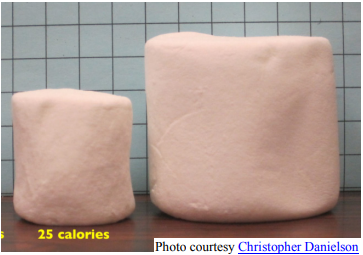
We would expect the calories to scale with volume. Since the marshmallows have cylindrical shapes, we can use that formula to find the volume. From the grid in the image, we can estimate the radius and height of each marshmallow.
The regular marshmallow appears to have a diameter of about 3.5 units, giving a radius of 1.75 units, and a height of about 3.5 units. The volume is about \(\pi(1.75)^{2}(3.5)=33.7 \text { units}^{3}\).
The jumbo marshmallow appears to have a diameter of about 5.5 units, giving a radius of 2.75 units, and a height of about 5 units. The volume is about \(\pi(2.75)^{2}(5)=118.8 \text { units}^{3}\).
We could now set up a proportion, or use rates. The regular marshmallow has 25 calories for 33.7 cubic units of volume. The jumbo marshmallow will have:
\(118.8 \text { units }^{3} \cdot \frac{25 \text { calories }}{33.7 \text { units }^{3}}=88.1 \text { calories }\)
It is interesting to note that while the diameter and height are about 1.5 times larger for the jumbo marshmallow, the volume and calories are about \(1.5^{3}=3.375\) times larger.
Try it Now 5
A website says that you’ll need 48 fifty-pound bags of sand to fill a sandbox that measure 8ft by 8ft by 1ft. How many bags would you need for a sandbox 6ft by 4ft by 1ft?
The original sandbox has volume \(64 \mathrm{ft}^{3}\). The smaller sandbox has volume \(24 \mathrm{ft}^{3}\).
\(\frac{48 \mathrm{bags}}{64 \mathrm{ft}^{3}}=\frac{x \mathrm{bags}}{24 \mathrm{ft}^{3}}\) results in \(x= 18\) bags.
Please ensure that your password is at least 8 characters and contains each of the following:
- a special character: @$#!%*?&
1-3 Measuring Segments

Here is your free content for this lesson!
Measuring Segments - Word Docs & PowerPoints
1-3 Assignment - Measuring Segments 1-3 Bell Work - Measuring Segments 1-3 Exit Quiz - Measuring Segments 1-3 Guided Notes - Student Edition - Measuring Segments 1-3 Lesson Plan - Measuring Segments 1-3 Online Activity - Measuring Segments 1-3 Slide Show - Measuring Segments
1-3 Assignment 1-3 Bell Work 1-3 Exit Quiz 1-3 Guided Notes SE 1-3 Lesson Plan 1-3 Online Activity 1-3 Slide Show
Want access to everything? Simply click the image below to Get All Lessons Here!

Find and Use Slopes of Lines
Teaching midpoint and distance in the coordinate plane, teaching congruent figures, triangle congruence by asa and aas, teaching perpendicular and angle bisectors, teaching bisectors in triangles, best geometry books for kids, proving theorems in geometry, how to prove lines are parallel, teaching logic in geometry, teaching angle pairs, proofs with uno cards, valentine’s day math activity – classifying quadrilaterals, christmas math worksheets, thanksgiving worksheet for geometry – happy turkey day, halloween geometry activities high school, how to teach classifying polygons, points lines and planes, tessellation project, the unit circle – hand trick, introduction to trigonometry, pi day top 5 for geometry teachers, polygons in the coordinate plane – how to use geogebra, teaching tessellations to your geometry class, 3 ways to make your life easier as a geometry teacher without more geometry worksheets, reasoning and proof, geometry games – dance dance transversal, midsegments of triangles, planning a proof, triangle congruence by sss and sas, pythagorean theorem – nfl and geometry, inequalities in one triangle, parallel lines cut by a transversal – colorful flip book notes, measuring angles putt-putt course design project, how to teach tangent lines – graphic organizer, segment addition postulate, two tips to teach volumes of prisms and cylinders, parallel lines and transversals, nets and drawings for visualizing geometry – geometry nets project, ratios and proportions – bad teacher, hybrid flipped classroom model, how to teach perimeter and area of similar figures – in jay leno’s garage, how to create a jeopardy game, 5 tips for new teachers, 8 teacher discounts you don’t want to miss this summer, your students are cheating with this math app, how to setup and use google classroom and google forms to teach geometry, special right triangles – the foundation of everything trig, how to use google forms and word clouds to help your students master their geometry vocabulary, interactive geometry teaching techniques, the magic octagon – understand congruence in terms of rigid motions, attention getters to keep your geometry class locked in, teaching strategies for your inclusion geometry class without an intervention specialist, how to teach the properties of quadrilaterals, how to make geometry interesting, how to teach circles using the common core standards, full year of geometry lesson plans, how a rock star geometry teacher uses the ipad to educate, are you a geometry teacher with no textbooks or geometry worksheets, how to deal with a class clown – classroom management strategies, geometry lessons | the game has changed | common core standards, teaching dimensions with super mario – geometry, lesson for the first day of geometry class.

IMAGES
VIDEO
COMMENTS
Find step-by-step solutions and answers to Geometry - 9780076639298, as well as thousands of textbooks so you can move forward with confidence. ... Section 1-1: Points, Lines, and Planes. Section 1-2: Linear Measure. Section 1-3: Distance and Midpoints. Section 1-4: Angle Measure. Page 45: Mid-Chapter Quiz. Section 1-5: Angle Relationships ...
Find step-by-step solutions and answers to Geometry - 9780547315171, as well as thousands of textbooks so you can move forward with confidence. ... Essentials of Geometry. Section 1.1: Identify Points, Lines, and Planes. Section 1.2: Use Segments and Congruence. Section 1.3: Use Midpoint and Distance Formulas. Page 23: Mixed Review of Problem ...
Find step-by-step solutions and answers to enVision Geometry - 9780328931583, as well as thousands of textbooks so you can move forward with confidence. ... Section 1-1: Measuring Segments and Angles. Section 1-2: Basic Constructions. Section 1-3: Midpoint and Distance. Section 1-4: Inductive Reasoning. Section 1-5: Conditional Statements ...
CORRECTIVE ASSIGNMENT NAME:_____ 1.1 POINTS, LINES, and PLANES DATE:_____ Use the figure on the right to answer 1-4. 1. Name a ray. 2. Name a line segment. 3. Name a pair of opposite rays. 4. Draw 𝑆𝑍⃖ ⃗ on the figure. Use the figure on the right to answer 5-12. NOTE: Line j intersects plane S at point T ...
Section 1.1 Points, Lines, and Planes. G.1.1 Demonstrate understanding by identifying and giving examples of undefined terms, axioms, theorems, and. inductive and deductive reasoning;
a. Help a Geometry teacher out by finding the exact location of Mr. Kelly on the map. Label it point K. b. Which postulate(s) help you locate Mr. Kelly? 6. Coordinate Geometry a. Graph the points F (2,7) U (-6,-5) N (-2, 4) b. State whether the three points are collinear or not. c. If the three points are not collinear, change the coordinate
It's easier to figure out tough problems faster using Chegg Study. Unlike static PDF Geometry, Student Edition 1st Edition solution manuals or printed answer keys, our experts show you how to solve each problem step-by-step. No need to wait for office hours or assignments to be graded to find out where you took a wrong turn.
Practice: Geometry Terms Real World: Basic Geometric Definitions This page titled 1.1: Geometry Terms is shared under a CK-12 license and was authored, remixed, and/or curated by CK-12 Foundation via source content that was edited to the style and standards of the LibreTexts platform; a detailed edit history is available upon request.
It's easier to figure out tough problems faster using Chegg Study. Unlike static PDF Prentice Hall Mathematics, Geometry 1st Edition solution manuals or printed answer keys, our experts show you how to solve each problem step-by-step. No need to wait for office hours or assignments to be graded to find out where you took a wrong turn.
View 1.1_HW_and_Answers.pdf from MATH HONORS at Edgewood Jr/sr High School. ... Discovering Geometry Practice Your Skills CHAPTER 1 1 02008 Kendall Hunt Publishing r'OF txemscs 3-4. name 63C" line For Exercises 5—7. 073w two points and label them.1'hcn use a min to draw each line. in two different wars. ... Answers to questions from lecture 1 ...
Find step-by-step solutions and answers to Big Ideas Math Geometry: A Common Core Curriculum - 9781642087611, as well as thousands of textbooks so you can move forward with confidence. ... Basics of Geometry. Section 1.1: Points, Lines, and Planes. Section 1.2: Measuring and Constructing Segments. Section 1.3: Using Midpoint and Distance ...
Assignment Date _____ Block_____ #_____ _ Cha. pter 1& 2: Introduction to Geometr. y . 1 1.1 - Points, Lines and Planes pgs 6-7{1 - 23 odd, 29- 45 odd} Segments, Rays, Parallel . Lines and Planes . 1.2 - Measuring Segments pgs 12- 13 {3 - 21 every 3. rd} 1.3- Midpoint and Distance pg 19- 20 {7-35 odd}
Section Assignment 1.1 Answer Key Principlesof Mathematics 11 Section Assignment 1.1 101 Version 04 Module 1. General Instructions for Assignments ... (-1) = -1 e) G(-3) = 6 f) H(2) = 1 y x 5 -5 3 -3 = H(x) Principles of Mathematics 11 Section Assignment 1.2, Answer Key 179 Module 1
The jumbo marshmallow appears to have a diameter of about 5.5 units, giving a radius of 2.75 units, and a height of about 5 units. The volume is about π(2.75)2(5) = 118.8 units3 π ( 2.75) 2 ( 5) = 118.8 units 3. We could now set up a proportion, or use rates. The regular marshmallow has 25 calories for 33.7 cubic units of volume.
pc_1.1_packet.pdf. File Size: 296 kb. File Type: pdf. Download File. Units 1 & 2 packets are free! To purchase the entire course of lesson packets, click here.
From a general summary to chapter summaries to explanations of famous quotes, the SparkNotes Building Blocks of Geometry Study Guide has everything you need to ace quizzes, tests, and essays. Search all of SparkNotes Search. Suggestions. Use up and down arrows to review and enter to select.
Our resource for Geometry: Homework Practice Workbook includes answers to chapter exercises, as well as detailed information to walk you through the process step by step. With Expert Solutions for thousands of practice problems, you can take the guesswork out of studying and move forward with confidence. Find step-by-step solutions and answers ...
A statement that is accepted as true without proof. Theorem. A statement that is proved using logical reasoning. Math. Geometry. Lesson 1.1: The Building Blocks of Geometry. Collinear Points. Click the card to flip 👆. Points that lie on the same line.
Free math problem solver answers your algebra homework questions with step-by-step explanations.
1-3 Assignment - Measuring Segments. 1-3 Bell Work - Measuring Segments. 1-3 Exit Quiz - Measuring Segments. ... Pre-Requisite Lessons - 4th, 5th, and 6th Grade Math Lessons: MathTeacherCoach. Find and Identify Angles in the Real World Money as Decimals Factors and Multiples: The Factor Factory Activity Subtraction Involving Mixed Numbers
Section 5.1. Polygon Angles. G.3.1: Identify and describe characteristics of convex, concave, and regular polygons. G.3.4: Determine the sum of both the interior and exterior angle measures of a polygon.
Find step-by-step solutions and answers to Discovering Geometry - 9781465255020, as well as thousands of textbooks so you can move forward with confidence. ... Section 1-1: Building Blocks of Geometry. Page 32: Coordinate Geometry Exercises. Section 1-2: Finding Angles. Section 1-3: Creating Definitions. Section 1-4: Polygons. Section 1-5 ...
Section 7.1 Pythagorean Theorem and Its Converse. Section 7.1. Pythagorean Theorem and Its Converse. G.2.3 Use the triangle angle sum theorem and/or the Pythagorean Theorem and its converse, to solve simple triangle problems. and justify results;